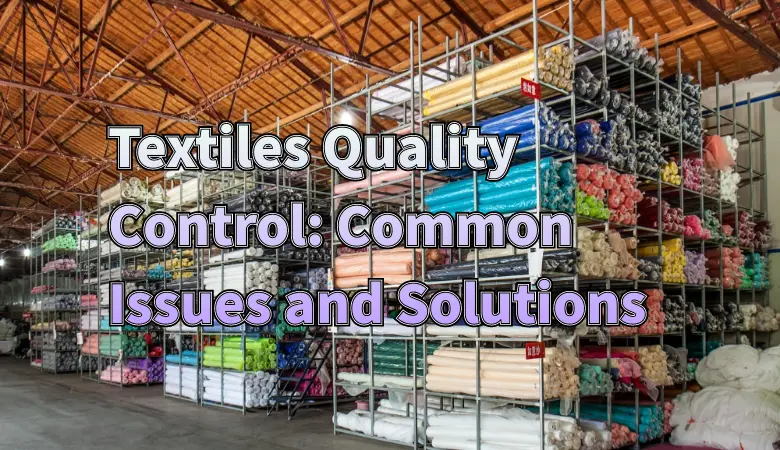Textile quality control is crucial to ensuring that products meet expected standards for performance, aesthetics, and durability. It directly impacts customer satisfaction, brand reputation, and ultimately the profitability of textile manufacturers.
The textile industry is a vast and diverse sector encompassing the production of fibers, yarns, fabrics, and finished textile products. It plays a pivotal role in the global economy, with applications ranging from clothing and home decor to technical textiles for various industrial purposes.

This article provides an overview of common quality issues, their causes, and effective quality control solutions in textiles. It serves as a guide for textile manufacturers, quality control personnel, and industry stakeholders to improve product quality and enhance competitiveness.
In the production process of textiles, quality control is a crucial step to ensure product quality and meet consumer demands. However, due to various factors, some quality issues often arise in textiles.
Fiber contamination issue: During the collection, processing, and storage of textile raw materials, various foreign particles or impurities, such as dust, leaves, and metal debris, may be mixed into the fibers. These contaminants not only affect the purity of the fibers but also have adverse effects on the quality and performance of the final product during subsequent processing, such as reducing the strength, abrasion resistance, and color fastness of the fabric.
Irregularities in yarn: Yarn is the basic unit that constitutes the fabric, and its quality directly affects the overall quality of the fabric. During the spinning process, if the thickness, strength, or appearance of the yarn changes, it can lead to unevenness in the fabric structure. This unevenness not only reduces the durability of the product but also affects the aesthetic appearance of the fabric, making the product more prone to breakage or deformation during use.
Weaving and knitting faults: During the weaving or knitting process, defects such as skipped stitches, yarn breaks, or uneven weave patterns may occur due to equipment malfunctions, improper operation, or raw material issues. These defects can seriously affect the appearance and strength of the fabric, making the product prone to breakage or deformation during use, thereby reducing its use value and market competitiveness.
Fabric shrinkage issue: During the processing or use of fabrics, uncontrolled shrinkage may occur if not properly treated or controlled. Shrinkage can lead to ill-fitting clothing or deformation of the fabric structure, seriously affecting the wearing effect and aesthetics of the product. Therefore, controlling the shrinkage rate of fabrics is a crucial issue that must be taken seriously in the textile production process.
Color difference phenomenon: Color inconsistency within a fabric or between different production batches is one of the common quality issues in textiles. This color difference may be caused by factors such as different dye batches, unstable dyeing processes, or equipment malfunctions. Color differences can affect the market competitiveness of products and reduce consumers' willingness to purchase and satisfaction.
Uneven dyeing issue: During the dyeing process, uneven dye absorption can lead to unsightly color variations in the final product. This uneven dyeing phenomenon may be caused by improper setting of dyeing process parameters, unstable dye quality, or equipment malfunction. Uneven dyeing not only affects the aesthetic appearance of the product but also reduces its market value and consumer recognition.
Poor printing quality: Printing is one of the important means to enhance the aesthetic appeal of textiles. However, issues such as blurring, fading, or misalignment during the printing process can significantly reduce the aesthetic value of textiles. These printing quality issues may be caused by malfunctions in printing equipment, instability in printing processes, or improper operation. Therefore, strict control of various process parameters and operational specifications is necessary during the printing process to ensure printing quality.
Chemical residue issues: During the processing of textiles, various chemicals may be used for bleaching, dyeing, finishing, and other treatments. If these chemicals are not completely removed or improperly controlled during processing, residues may remain in the product. These chemical residues may pose risks to human health, such as causing skin allergies and irritating the respiratory tract. At the same time, chemical residues can also affect the texture and appearance of the product, reducing its use value and market competitiveness. Strict control of the usage and removal of chemicals during textile processing is necessary to ensure the safety and quality of the product.
Fiber quality variation: The fiber quality in raw materials is one of the key factors determining the quality of the final product. Fiber quality often exhibits inconsistency, which may stem from various factors such as the origin of raw materials, growth conditions, harvesting season, etc. Inconsistency can directly lead to differences in the performance, appearance, and durability of the final product, thereby affecting the consumer experience and market competitiveness of the product.
Supplier reliability: The reliability of suppliers is a crucial aspect in ensuring the quality of raw materials. Unreliable suppliers may provide substandard materials that contain impurities, have non-compliant compositions, or exhibit other defects. Using such raw materials for production will undoubtedly lead to quality issues in the final product, thereby damaging the reputation of the enterprise and undermining consumer trust.
Machine malfunctions: During the production process, the normal operation of machinery and equipment is the foundation for ensuring product quality. Equipment malfunctions, such as yarn breakage, incorrect fabric weaving, or improper handling of finished products, occur from time to time. These malfunctions can lead to production interruptions and may also cause permanent defects in yarn, fabric, or finished products, seriously affecting the quality and appearance of the products.
Human error: Operators play a crucial role in the production process. Human error is also a significant factor leading to quality issues. Operators may make mistakes due to fatigue, negligence, or lack of training, such as improper operation, incorrect settings, or neglecting quality checks. These errors can result in product defects and even trigger batch-wide quality issues.
Ineffective process control: Effective process control is crucial for ensuring consistent product quality. Inadequate process control measures or poor implementation can lead to fluctuations in product quality. For instance, the absence of rigorous quality inspection processes, inaccurate monitoring equipment, or incomplete data recording may all result in inferior products reaching the market, thereby tarnishing the brand image of the enterprise.
Changes in humidity and temperature: During the processing of textiles, fluctuations in environmental conditions have a significant impact on product quality. Changes in humidity and temperature may cause fibers to absorb or release moisture, thereby affecting the dimensional stability, hand feel, and appearance of textiles. Extreme environmental conditions may also accelerate the aging process of fibers and reduce the durability of the product.
Storage conditions: The storage conditions of raw materials are also crucial to product quality. Poor storage environments, such as high temperatures, humidity, or inadequate ventilation, may lead to mold growth, discoloration, or deterioration of raw materials and finished products. Improper stacking methods may also cause indentation, wrinkling, or damage to products, further affecting their quality and sales value.
To ensure excellent and stable product quality, a comprehensive and meticulous quality control solution is implemented. The solution encompasses preventive measures before production, real-time monitoring during production, and strict quality control after production, providing comprehensive protection for product quality.
Raw material inspection: We conduct comprehensive and thorough inspections on all raw materials entering the production line. Through rigorous testing methods and standards, we ensure that each batch of raw materials meets the established quality standards, laying a solid foundation for producing high-quality products.
Supplier audit: We conduct regular and rigorous audits and evaluations of our suppliers. By assessing their reputation, past performance, and quality control practices, we ensure that the suppliers we choose are reliable and trustworthy partners, thereby guaranteeing the quality of raw materials from the source.
Machine maintenance and calibration: We are well aware of the importance of equipment in the production process, so we regularly maintain and calibrate production equipment. Through a professional maintenance team and advanced calibration technology, we ensure that the equipment is always in optimal working condition, effectively preventing quality issues caused by equipment malfunctions.
Real-time monitoring: We have established a comprehensive production monitoring system to continuously monitor every aspect of the production process. Through real-time data analysis and abnormal alarm mechanisms, we can promptly identify and correct defects in the production process, ensuring consistent product quality.
Employee training: We focus on enhancing the professional skills and quality awareness of our operators. Through regular training and educational activities, we enable operators to master operational procedures proficiently, reduce the likelihood of human errors, and provide strong guarantees for producing high-quality products.
Final inspection and testing: Before the products leave the factory, we conduct rigorous final inspection and testing. Through comprehensive testing items and strict testing standards, we ensure that every finished product meets the quality requirements and expectations of our customers.
Quality assurance standards: We have implemented strict quality assurance standards and procedures. Through standardized operational processes and rigorous quality control point settings, we ensure the stability and consistency of product quality, providing customers with reliable product guarantees.
Customer feedback integration: We attach great importance to customers' feedback. By actively collecting and analyzing customer feedback, we can promptly identify and address specific issues with our products. At the same time, we incorporate customer feedback into our quality control process, continuously improving and optimizing our products to meet customers' expectations and demands.
The future of textile quality control lies in the adoption of advanced technologies such as automation and artificial intelligence, aiming to enhance efficiency, accuracy, and transparency. It is hoped that everyone can continuously improve their quality control processes, embrace cutting-edge technologies, and prioritize customer feedback, ensuring that products meet the highest quality standards.

The Smart Sourcing & Quality Assurance Content Team is dedicated to delivering high-quality, easy-to-understand information that empowers our audience to navigate the complexities of global sourcing and quality assurance. Our team of writers has extensive experience in creating content across various fields, including procurement, supply chain management, quality assurance, market trends, and industry best practices. We specialize in sectors such as apparel, textiles, and consumer goods, providing targeted insights to help businesses in these industries optimize their sourcing strategies, ensure product quality, and maintain a competitive edge in the market.